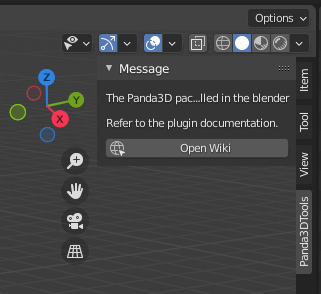First release for tests and suggestions.
As always happens after a release, a serious bug was discovered.
I replaced the archive, to fix it.
I found some time to review your exporter. The logic and core features look good, also nice code style.
The add-on does not seem to install under my copy of Blender 2.93 – here is the error:

Maybe this has something to do with period “0.1” truncation in the name of the add-on.
Panda3DTools-0.1
Hmm, I didn’t give it a name that way. Maybe you named the folder that way?
I have so.
https://github.com/serkkz/Panda3DTools/releases/download/0.1/Panda3DTools.zip
Thanks, that fixed it.

Now the Panda3DTools are installed and I can see the N-tab. However, only the intro message is shown.

In fact, it should be. You need to install the panda in the blender, this page just says how to do it.
Blender for Linux may not include pip by default according to this thread: #71856 - No longer able to install pip on 2.81 - blender - Blender Projects
Indeed, on a fresh install of Blender 2.93 on Ubuntu, this script fails:
import bpy
import subprocess
import ensurepip
ensurepip.bootstrap()
import pip
Traceback (most recent call last):
File “<blender_console>”, line 1, in
ModuleNotFoundError: No module named ‘pip’
import pip3
Traceback (most recent call last):
File “<blender_console>”, line 1, in
ModuleNotFoundError: No module named ‘pip3’
I’m working on a solution for this.
Partial solution for Ubuntu users:
- Download self-contained version of Blender 2.93 from Download — blender.org
- Extract the .tar.xz
- Open a Terminal window in:
/blender-2.93.0-linux-x64/blender-2.93.0-stable+blender-etc-etc-etc-etc-etc/2.93/python/bin
-
Execute ensurepip in the following manner from the Terminal window:
./python3.9 -m ensurepip -
Open the “blender” executable in the top-level of the extracted Blender directory
-
Begin recommended add-on installation routine here Installation · serkkz/Panda3DTools Wiki · GitHub
Unfortunately, the recommended installation routine fails at the add-on activation stage, with Blender 2.93 immediately crashing to the desktop. At the moment my best guess is that --upgrade pip wants to install 21.1.2 but we’re looking for 21.1.1
@Simulan Thank you for investigating, If you were able to install the package manager, you can use it for self-installation. With the possibility of the desired version.
python.exe -m pip install pip==21.1.1
In fact, you can ignore this pip upgrade step, just go ahead and install Panda3D.
Demonstrates the progress for the pipeline, the feature is that any pipeline can be designed.
Simulation of slots is solved by sorting the image node by vertical coordinate.
Note: the repository is no longer being updated, so I don’t see the point in this.
The other day I wondered how to implement complex collision nodes when exporting, a node that consists of several solid objects. As a solution, I came up with the idea of creating a collection and linking it to a node. When exporting, add all objects in this collection to the collision node. At the moment, I decided to support only the collision polygon, sphere and cube, since the types of empty objects are limited, it is not convenient to use physics bodies. However, I think this will be enough to create, for example, levels, etc.
I created a short video with subtitles describing the actions
A week has passed. I have redesigned the composite objects, now they are based on a hierarchy. If you need to add in object in the form of a body, solid, or shape, it is enough to mark the node with the necessary label. The bullet engine is now supported, you can export complex nodes from the mesh, box, and sphere node.
Tools have also been added to speed up work with textures. A link to the video is attached. From this day on, I officially declare that panda3d-simplepbr is fully supported.
Very nice! It seems that this is proceeding well! ![]()
One thing, if I may: in terms of collision-shapes, I tend to find that capsules are amongst the most useful. Indeed, for level-building I suspect that I use them more often than anything other than polygons.
Perhaps they might be represented by appropriately-tagged models, using extents to define the specifics of the capsules?
Thank you for paying attention to the lack of capsule shape. The fact is that I doubted its necessity, but after reading your post, I will add it.
I suppose an empty box can be tagged as a capsule, where scaling by Z will represent the height, X or Y radius, I think the lowest value should be used for the principle of fitting into the box frame.


